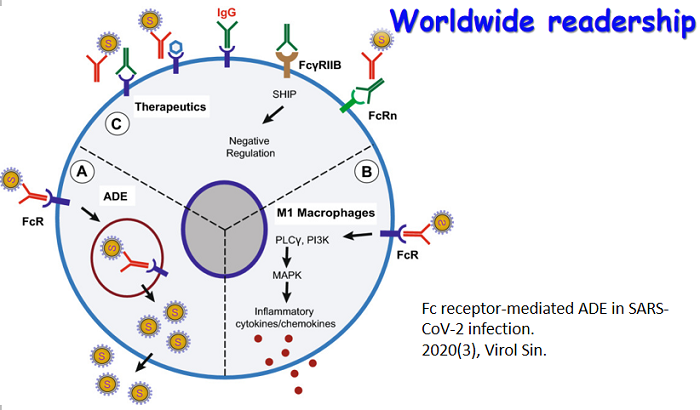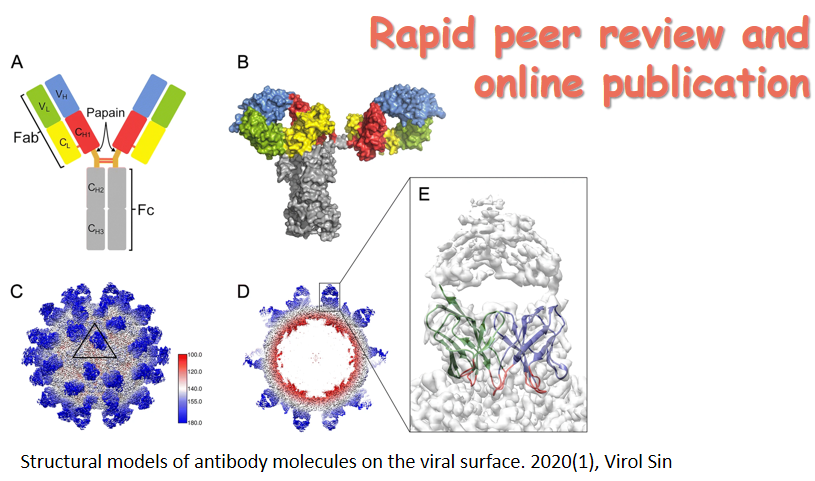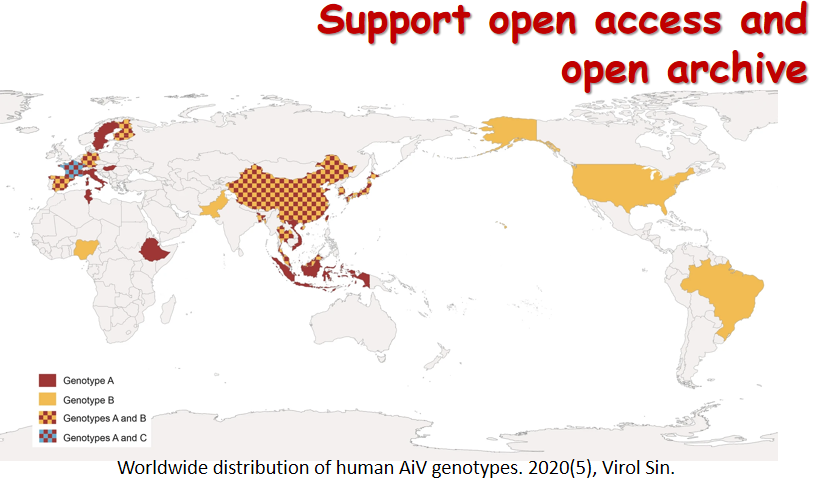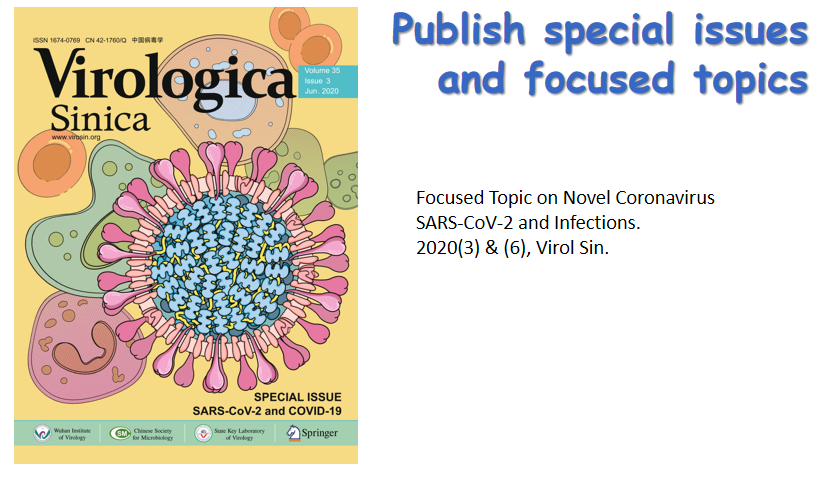Column
|
Ten strains of virus were isolated from vesicle fluid of skin lesions of 12 patients with variclla or herpes zoster by means of Vem-E6 eeUs.The postive rate was 83.3% These viruses all cause typical cell damages such as rounded and shrivelled,fusion and fallout.These damages got quick following increased future degenerations The typical fluorescence lump of nucleus within the infected cells would be found by indirect immunofluorescence technique.The antigen samples prepared with virusinfected cells could be used to examine the sera of patients with herpes zoster and it could be found that the antibody titer in recovering stage was four times as much as that in acute stage.VZV was sensitive to Vero cells and not sensitive to the primary simple-lager cells from M eriones unguiculatus kidney, fetal rabbit kidney and fetal guinea pig kidney,lung and spleen VZV was nsensitive to newborn white mouse too.The viruses would die within one week at 一20℃ 。but they can be preserved in Eagle。s solution containing de-fat milk,newborn bovine serum and sorbitol at 一100℃ over two years
HGV NS5 cDNA of two Hong Kong strains and one Guangdong strain were amplified by re
verse transcription polymerase chain reaction (RT-PCR).T}le products were inserted into pUC19 vect0rs
respectively.~fter transfecting DH5a and JM 109 strains.the reeombinants were screened and identified
by PCR and dig ted wlth restriction erldDnudeses.n 1e nudeotldes were sequenced by the Ndmxy chain
termination method n 1e homologies d HGV NS5 r~ ion nucleotide and d~umdlTlillO acid sequences
were 93 3% 一94% and 97% 一99.2% re印ecnve【v between eachHangKong strainandtheGtm~dong
strain an dwere 90% 一91 2% and 94% 一96 3% ,87.1% 一89.5% an d 95.2% 一97% 91 4%
93 8% and 97% 97 9% respectively Compared with the reported China isolate(CN) American iso
lates(PNF2161 and R10291),and West African lsolated(GBV-C) T}1e variant sites of the nudeotides
appear spor~ ieally T}le nucleotide an d ded umd amino acid seQuences of HGV NS5 genornic region are
relatively conserved ,andit also sog gests thatthe nudeotide variation ofHGV may beinfluenced by geo
graphical factors
The mutated gene of dsFv to HBsAg by PCR based point mutagenesis method was constructed and sequenced. The mutated genes of VH and VL were cloned into plasmid pET 20 b and sequenced with the dideoxynucleotid method. The results showed that the cysteines were introduced into position 44 aa of VH and position 100 aa of VL. The recombinaint plasmids of VH and VL which were transformed into E.coli BL21 (DE3) separately produced a 1.2 kD inclusion body protien upon induction with IPTG. The expression level of VH(and VL) protein was 28% (and 35%). VH and VL inclusion bodies were solubilized and combined in equal molar ratio in the refolding solution. Then, VH and VL were folded into a 24 kD protein anti HBs dsFv which showed strong binding to HBsAg. These have laid a fundation to apply the dsFv against HBsAg.
RNA of Hantaan virus (HNTV) strain Chen isolated from China was extracted from lysate of Vero E 6 cell infected by the virus. With the RNA as template, 1.3kb cDNA fragment containing the region encoding nucleocapsid protein (NP) was obtained by reverse transcription polymerase chain reaction (RT PCR). This fragment was cloned into pGEM 7zf(+) plasmid and sequenced. Homology comparision showed that the homology of the nucleotide and amino acid sequences between strain Chen and strain 76 118 was 86% and 97%, respectively. The RT PCR product was cloned into pGEX 4T 1 vector and was efficiently expressed in E.coli . The expressed product is NP GST fusion protein with molecular weight about 70 kD in SDS pAGE. Its antigenic epitope was recognized by Western blotting and ELISA using the McAbs. The results showed that there were some differences on antigenic epitopes between strain Chen and strain 76 118.
The HBV HBsAg coding region of a hepatitis B patient was analyzed by PCR amplification, bacteriophage cloning and nucleotide sequencing. It was showed that among different clones from the same patient there were point mutations and these different nucleotide changes were not resulted from the methodologies. It is concluded that there are polymorphic HBV genomes within the same hepatitis B patient
LsNPV DNA restriction fragments were hybridized with p 35 gene fragment of AcNPV. The 5.5 kb fragment of LsNPV was cleaved by single and double degestion and its physical map was constructed. After subcloning and sequencing, a intact ORF that is 906 bp in length, deduced amino acids are 302 in number was found. There are GC, ACGT motif and TATA box which are specific sequence of promoter of baculoviruses early gene. This ORF of LsNPV was compared with p 35 gene of AcNPV, and 80.4% nucleotide sequence homology and 70.4% amino acid sequence homology were found between two genes. Furthermore, in its promoter region there is 22 bp forward repeat, including 2 sets of promoter units, each is composed of 2 overlapping TATA box and 2 sets of ACGT motif in the upstream and the downstream of TATA box.
The intergenic sequence (IS) cDNA of Potato Leafroll Virus (PLRV) Chinese isolate was constructed into transformation binary vector pROK2 in positive or negative direction, then introduced into the commercial potato cultivar Desiree via Agrobacterium tumefaciens mediated gene transfer. Kanamycin resistance, PCR amplification of transgenic lines showed that intergenic sequence of PLRV Ch was integrated into the genome of potato plants. The transgenic lines were transplanted into the screen house, then inoculated with PLRV by viruliferous Myzus persicae Sulz. After inoculation, the symptom development was observed and the virus titer was detected by ELISA. Results showed that the transgenic plants displayed slight or no symptom. The average PLRV titer in the transgenic lines was lower than the untransformed plants. The transgenic lines expressing sense RNA reduced PLRV titers about 43%~72% in comparison with untransformed plants, while the transgenic lines expressing antisense RNA reduced about 72%~86%. It
Comparative studies on biological properties, physical and biochemical properties, morphology and serological relationships of five cucumber mosaic virus (CMV) isolates (PE,PE2,PEf,PC,PF) infecting Passiflora edulis, P. edulis P.edulis var. flavicarpa, P.edulis var. flavicarpa, P.caerulea, P.foetida were carried out. There were differences in host reactions and serological relationships of five CMV isolates. However, similarities were found in viral particle morphology, stability in sap, aphid transmission, molecular weight of coat protein of five CMV isolates. According to the host reactions and serological relationships, these five isolates could be divided into two CMV subgroups, among which PE, PE2,PC,PF belonged to subgroup I and PEf to subgroupII.
By two pairs of primers complementory to the published sequences at the both sides of EcoRI site and BamHI site on CAV circular genome, two DNA fragments containing two parts (1.5 kb and 0.8 kb) of CAV genome divided by EcoRI and BamHI sites were amplified by PCR from the circular CAV genome (2.3 kb) detected by dot blot in genomic DNA of CAV infected RP1 cells. Through re ligation of the selected sequences from the amplified fragments, the whole CAV genomic DNA was cloned into pUC18, and the recombinant plasmid was designated as pCAV2.4. Restriction endonucleases analysis of pCAV2.4 showed that there were sites of BamHI、PstI、HindⅢ,but no site of EcoRI. Two ends of cloned DNA sequence analysis showed that the recombinant plasmid pCAV2.4 containes the whole genomic DNA sequence of CAV, and that the site sequence of EcoRI in the cloned DNA was changed by one base substitution.
Grass Carp Hemorrhage Virus (GCHV) was purified from infected fish cell culture by using different centrifugation. Its total genome was isolated by proteinase K treatment following phenol/chloroform extraction. The individual segment of GCHV dsRNA was separated by running 1% agarose gel electrophoresis and recovered by Gel Extraction Kit. Each segment was denatured in 90% DMSO by heating at 70℃ for 15min. The cDNAs of several segments were synthesized with random hexamers method and cloned into EcoRV site of pZErO 2.0 vector, then transformed into TOP10 E.coli competent cell by electroporation transformation. It was showed that the recombinant plasmids contained GCHV RNA genome of interest by dot hybridization besides both restriction analysis and PCR amplification. The partial DNA sequence of GCHV segment 11 was analysed.
Six of anti HIV 1 sero positive plasma derived from a local high risk population were investigated by RT PCR and cDNA sequencing. The results indicated that HIV 1 prevalent in a local high risk population belonged to HIV 1 subtype B. The sequences of nucleic acids and amino acids in V3 loop of 6 cDNA were completely similar to that of Thailand HIV 1 subtype B strains. Besides, the sequences of cDNA and amino acid from 6 plasma samples were identical. It implied that they might be derived from 6 HIV 1 infected people who were infected with HIV 1 at the same period. This study could provide a better understanding of prevelence of HIV 1 subtype strains in a local high risk population.
The hemorrhagic Fever with Renal Syndrome Virus was exposed 0,30,60,90,120 minutes respectively on the surface of glass plate in the natural condition of indoor (dry bulb temperature: 27.5℃, wet bulb temperature: 25.2℃, RH 82%). The survival of them was observed although virus was exposed up to 120 minutes, the potency of HFRSV still reach the level of 10 4.23 TCID 50 . The work has provided scientific data for the study of epidemiology of HFRS and etiology about HFRSV
Detection had been made for the levels of serum specificity IgA, IgE antibodie and specificity of virus antigens circulation immune complexes (CIC) on the different days or phases of illness and clinic types in patients of HFRS. The results showed that the level of specific IgA antibody was higher in slight cases than in middle and severe; specific IgE antibody and its CIC was higher in severe cases than in slight and middle. Those differences were apparent in acute phase (illness phase of fever and shock oilguria, or 3-8 days after illness). But specific CIC IgA types had no diferences
A total of 19 367 adult female mosquitoes belonging to 16 species of Aedes genus were captured from nine countries, south western part of Yunnan Province, China, and were examined by C6/36 cell method and suckling mouse method. Two strains of Japanese encephalitis (JE) virus were isolated from 6491 (185 pools) Aedes albopictus , two strains of JE virus were isolated from 1605 (50 pools) Ae. vexans, two strains of JE virus were isolated from 772 (23 pools) Ae. lineatopennis, and a strain of JE virus was isolated from 103 (4 pools) Ae. assamensis. Isolation of JE virus was negative to other 12 species of Aedes mosquitoes. Ae. albopictus was the superior species of mosquitoes in bamboo forest. These results indicated that Ae. albopictus from Yunnan has a potential role in the maintenance and transmission of JE virus in nature. Ae. vexans, Ae. lineatopennis and Ae. assamensis are also considered to be transmitting vector of JE virus in Yunnan.

















